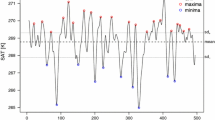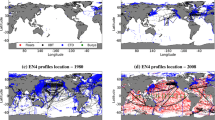Abstract
The modern climate of our planet is characterized not only by a trend caused by an increase in the concentration of greenhouse gases in the atmosphere, but also by fluctuations covering a wide range of frequencies and scales. The global climate variability based on the modeling results of the Coupled Model Intercomparison Project Phase 5 of the World Climate Research Program is characterized by significant differences between models. In particular, for the decadal-scale anomalies of the global and hemispheric temperatures, the standard deviation differences between models are as high as fourfold. However, in contrast to the differences in climate sensitivity between models, the causes of a wide range of the estimates of climate variability are still not entirely understood. The research in this paper is based on two-component energy-balance stochastic model. We analyze the sensitivity of interannual and interdecade variability of the mean global surface temperature (GST) to the feedback and thermal inertia of the atmosphere–ocean system under the assumption that the main external forcing factor is random fluctuations of the radiation balance at the upper boundary of the atmosphere. We estimate the influence of thermal inertia and feedback in the climate system on the interannual and interdecade variability (variance) of the GST and the spectrum of its fluctuations using the absolute and relative sensitivity functions derived in the research.



Similar content being viewed by others
REFERENCES
E. Rozenwasser and R. Yusupov, Sensitivity of Automatic Control Systems (CRC, Boca Raton, FL, 2000).
D. V. Gaskarov, V. B. Kiselev, S. A. Soldatenko, et al., Introduction to Geophysical Cybernetics, Ed. by R. M. Yusupov (SPbGU, St. Petersburg, 1998) [in Russian].
S. Soldatenko, “Weather and climate manipulation as an optimal control for adaptive dynamical systems,” Complexity 2017, 4615072 (2017).
G. I. Marchuk and Yu. N. Skiba, “The role of adjoint functions in studying the sensitivity of the model of thermal influence of the atmosphere and ocean to initial data variations,” Izv. Akad. Nauk SSSR: Fiz. Atmos. Okeana 26 (5), 451–460 (1990).
V. P. Dymnikov, E. M. Volodin, V. Ya. Galin, et. al., “Sensitivity of a climatic system to small external forcings,” Meteorol. Hydrol., No. 4, 77–91 (2004).
V. V. Penenko, “Variational methods of data assimilation and inverse problems for studying the atmosphere, ocean, and environment,” Numer. Anal. Appl. 2 (4), 341–351 (2009).
S. Soldatenko and R. Yusupov, “Parametric sensitivity in geoengineering and controlling the weather and climate,” WSEAS Trans. Environ. Dev. 11, 289–301 (2015).
Climate Change 2013: The Physical Science Basis. Contribution of Working Group I to the Fifth Assessment Report of the Intergovernmental Panel on Climate Change, Ed. by T. F. Stocker, D. Qin, G.-K. Plattner, (Cambridge Univ. Press, Cambridge, 2013).
G. Myhre, E. J. Highwood, K. P. Shine, and F. Stordal, “New estimates of radiative forcing due to well mixed greenhouse gases,” Geophys. Res. Lett. 25, 2715–2718 (1998).
G. D. Myhre, F.-M. Shindell, W. Breon, et al., “Anthropogenic and natural radiative forcing supplementary material,” in Climate Change 2013: The Physical Science Basis. Contribution of Working Group I to the Fifth Assessment Report of the Intergovernmental Panel on Climate Change, Ed. by T. F. Stocker, D. Qin, G.-K. Plattner, (Cambridge Univ. Press, Cambridge, 2013), pp. 659–740.
P. M. Cox, C. Huntingford, and M. S. Williamson, “Emergent constraint on equilibrium climate sensitivity from global temperature variability,” Nature 553, 319–322 (2018).
S. Bony, R. A. Colman, V. Kattsov, et al., “How well do we understand and evaluate climate change feedback processes?,” J. Clim. 19, 3445–3482 (2006).
O. Boucher, D. Randall, P. Artaxo, et al., “Clouds and aerosols,” in Climate Change 2013: The Physical Science Basis. Contribution of Working Group I to the Fifth Assessment Report of the Intergovernmental Panel on Climate Change, Ed. by T. F. Stocker, D. Qin, G.-K. Plattner, (Cambridge Univ. Press, Cambridge, 2013), pp. 571–657.
M. Collins, R. Knutti, J. Arblaster, et al., “Long-term climate change: Projections, commitments and irreversibility,” in Climate Change 2013: The Physical Science Basis. Contribution of Working Group I to the Fifth Assessment Report of the Intergovernmental Panel on Climate Change, Ed. by T. F. Stocker, D. Qin, G.-K. Plattner, (Cambridge Univ. Press, Cambridge, 2013), pp. 1029–1136.
G. Flato, J. Marotzke, B. Abiodun, et al., “Evaluation of climate models,” in Climate Change 2013: The Physical Science Basis. Contribution of Working Group I to the Fifth Assessment Report of the Intergovernmental Panel on Climate Change, Ed. by T. F. Stocker, D. Qin, G.-K. Plattner, (Cambridge Univ. Press, Cambridge, 2013), pp. 741–866.
N. G. Loeb, W. Su, and S. Kato, “Understanding climate feedbacks and sensitivity using observations of Earth’s energy budget,” Curr. Clim. Change Rep. 2, 170–178 (2016).
B. Soden and I. M. Held, “An assessment of climate feedbacks in coupled ocean–atmosphere models,” J. Clim. 19, 3354–3360 (2006).
J. M. Gregory, W. J. Ingram, M. A. Palmer, et al., “A new method for diagnosing radiative forcing and climate sensitivity,” Geophys. Res. Lett. 31, L03205 (2004).
J. M. Gregory and T. Andrews, “Variation in climate sensitivity and feedback parameters,” Geophys. Res. Lett. 43, 3911–3920 (2016).
J. Hansen, A. Lacis, D. Rind, et al., “Climate sensitivity: Analysis of feedback mechanisms,” in Climate Processes and Climate Sensitivity, Ed. by J. E. Hansen and T. Takahashi (Am. Geophys. Union, 1984), vol. 5, pp. 130–163.
H. Karper and H. Engler, Mathematics and Climate (SIAM, Philadelphia, 2013).
G. Roe, “Feedbacks, timescales, and seeing red,” Annu. Rev. Earth Planet. Sci. 37, 93–115 (2009).
B. Kirtman, S. B. Power, J. A. Adedoyin, et al., “Near-term climate change: Projections and predictability,” in Climate Change 2013: The Physical Science Basis. Contribution of Working Group I to the Fifth Assessment Report of the Intergovernmental Panel on Climate Change, Ed. by T. F. Stocker, D. Qin, G.-K. Plattner, (Cambridge Univ. Press, Cambridge, 2013), pp. 953–1028.
K. E. Taylor, R. J. Stouffer, and G. A. Meehl, “An overview of CMIP5 and the experiment design,” Bull. Am. Meteorol. Soc. 93, 485–498 (2011).
R. A. Colman and S. B. Power, “What can decadal variability tell us about climate feedbacks and sensitivity?,” Clim. Dyn. 51, 3815–3828 (2018).
S. Soldatenko and R. Colman, “Climate variability from annual to multi-decadal timescales in a two-layer stochastic energy balance model: Analytic solutions and implications for general circulation models,” Tellus A 71, 1–15 (2019).
H. von Storch and F. W. Zwiers, Statistical Analysis in Climate Research (Cambridge University Press, New York, 2001).
R. A. Colman and S. B. Power, “Atmospheric feedbacks under unperturbed variability and transient climate change,” Clim. Dyn. 34, 919–934 (2010).
H. Bellenger, E. Guilyardi, J. Leloup, et al., “ENSO representation in climate models: From CMIP3 to CMIP5,” Clim. Dyn. 42, 1999–2018 (2014).
K. L. Ricke and K. Caldeira, “Maximum warming occurs about one decade after a carbon dioxide emission,” Environ. Res. Lett. 9, 124 002 (2014).
Z. Liu, “Dynamics of interdecadal climate variability: A historical perspective,” J. Clim. 25, 1963–1995 (2012).
V. A. Semenov, “Kolebaniya sovremennogo klimata, vyzvannye obratnymi svyazyami a sisteme atmosfera - arkticheskie l’dy–okean,” Fundam. Prikl. Klimatol. 1, 232–248 (2015).
S. B. Power and F. P. D. Delage, “El Niño–Southern Oscillation and associated climatic conditions around the world during the latter half of the twenty-first century,” J. Clim 31, 6189–6207 (2018).
E. Middlemas and A. Clement, “Spatial patterns and frequency of unforced decadal scale changes in global mean surface temperature in climate models,” J. Clim 29, 6245–6257 (2016).
K. Hasselmann, “Stochastic climate models. Part I. Theory,” Tellus 28, 473–485 (1976).
J. M. Gregory, “Vertical heat transport in the ocean and their effect on time-dependent climate change,” Clim. Dyn. 16, 501–515 (2000).
I. M. Held, M. Winton, K. Takahashi, T. Delworth, F. Zeng, and G. K. Vallis, “Probing the fast and slow components of global warming by returning abruptly to preindustrial forcing,” J. Clim. 23, 2418–2427 (2010).
O. Geoffroy, D. Saint-Martin, D. J. L. Olivié, A. Voldoire, G. Bellon, and S. Tytéca, “Transient climate response in a two-layer energy-balance model. Part I: Analytical solution and parameter calibration using CMIP5 AOGCM experiments,” J. Clim. 26, 1841–1857 (2012).
A. S. Ginzburg and P. F. Demchenko, “Air temperature and energy consumption feedbacks within urbanized areas,” Izv., Atmos. Ocean. Phys. 53 (5), 487–494 (2017).
P. F. Demchenko and A. V. Kislov, Stochastic Dynamics of Natural Objects. Brownian Motion and Geophysical Examples (GEOS, Moscow, 2010) [in Russian].
S. A. Soldatenko and R. M. Yusupov, “Optimal control of aerosol emissions into the stratosphere to stabilize the Earth’s climate,” Izv., Atmos. Ocean. Phys. 54 (5), 480–486 (2018).
S. A. Soldatenko and R. M. Yusupov, “Sensitivities of a zero-dimensional climate model and its feedbacks in the context of the problem of weather and climate control,” Tr. SPIIRAN 52, 5–31 (2017).
C. E. Leith, “The standard error of time-average estimates of climate means,” J. Appl. Meteorol. 12, 1066–1069 (1973).
P. F. Demchenko and V. A. Semenov, “Estimation of uncertainty in surface air temperature climatic trends related to the internal dynamics of the atmosphere,” Dokl. Earth Sci. 476 (1), 1105–1108 (2017).
S. Heinz, Mathematical Modelling (Springer, Berlin–Heidelberg, 2011).
E. S. Venttsel’, Theory of Probabilities (Vysshaya shkola, Moscow, 1999) [in Russian].
S. E. Schwartz, “Heat capacity, time constant, and sensitivity of Earth’s climate system,” J. Geophys. Res. 112, DS24S05 (2007).
A. Hall and S. Manabe, “Can local linear stochastic theory explain sea surface temperature and salinity variability?,” Clim. Dyn 13, 167–180 (1997).
ACKNOWLEDGMENTS
We thank P.F. Demchenko for constructive and very useful discussions during the preparation of this work.
Author information
Authors and Affiliations
Corresponding author
Additional information
Translated by E. Morozov
Rights and permissions
About this article
Cite this article
Soldatenko, S.A., Yusupov, R.M. Estimating the Influence of Thermal Inertia and Feedbacks in the Atmosphere–Ocean System on the Variability of the Global Surface Air Temperature. Izv. Atmos. Ocean. Phys. 55, 591–601 (2019). https://doi.org/10.1134/S000143381906015X
Received:
Revised:
Accepted:
Published:
Issue Date:
DOI: https://doi.org/10.1134/S000143381906015X




